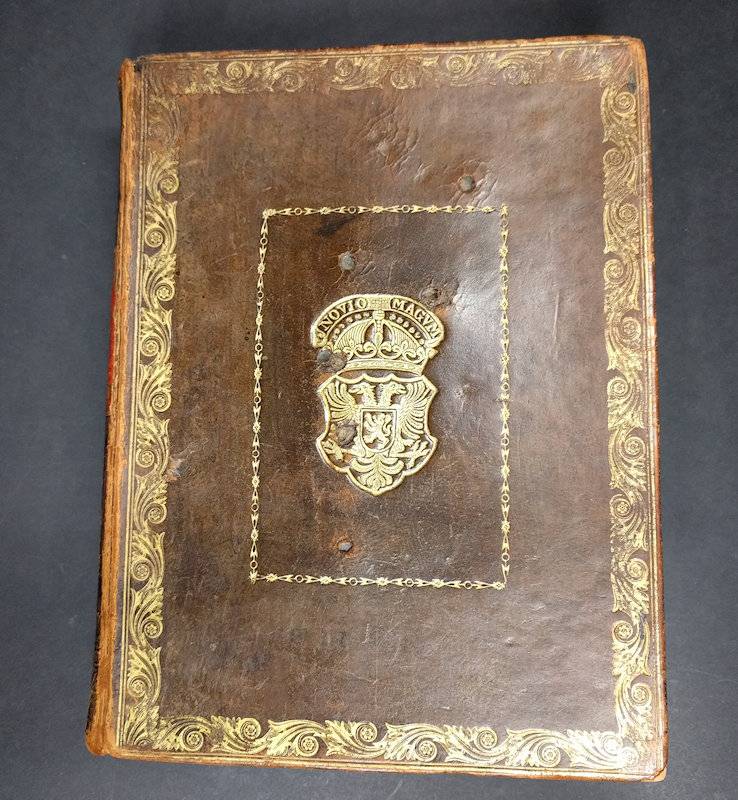SILIUS ITALICUS.
Caji Silii Italici Punicorum libri septemdecim. Cum excerptis ex Francisci Modii, novantiquis lectionibus, et Casp. Barthii adversariis, tum Danielis Heinsii crepundiis Silianis, et postumis notis Nicolai Heinsii, nunc primum editis, curante Arnoldo Drakenborch, cujus etiam annotationes passim additae sunt.
Utrecht (Trajecti ad Rhenum), Apud Guilielmum vande Water, Academ. Typogr., 1717.
4to. (XXXII),880,(26 index) p.; frontispiece, 8 plates. Calf 25 cm (
Ref: STCN ppn 213091291; Schweiger 2,955; Dibdin 2,406: 'celebrated and elaborate edition'; Brunet 5,383; 'une des meilleurs éditions que l'on ait de ce poëme'; Fabricius/Ernesti 2,177: 'subiiciuntur copiosae et eruditae Drakenborchii ipsius observationes'; Graesse 6/1,405; Ebert 21230: 'sehr gesucht'; Spoelder Nijmegen 6, p. 657) (
Details: Prize copy, without the prize. Back gilt, and a red shield in the second compartment. Gilt coat of arms of Nijmegen, within gilt borders on both boards. Frontispiece designed and engraved by J. Goeree, it depicts Roma standing on the spoils won in the battles against the Carthagians. Title in red and black. Vande Water's woodcut printer's mark on the title, it depicts Fama flying over a city which emerges from 2 cornucopiae, the motto is: 'Pax artium Altrix') (
Condition: Prize removed. Binding rubbed, and with wear to the extremities. Large ink spot on the back. Good quality paper. It is true, Silius Italicus is tough reading, but a former owner went too far in his loathing. The book once served a boy for a more practical aim, shooting practice: the coat of arms of Nijmegen on the upper and lower board apparently was used as bull's-eyes, probably for a small calibre air-rifle. There are 10 small impacts, 3 of which more or less penetrated the boards halfway; the impact of those 3 bullets bruised the front endpapers and the paper of the first gatherings. These bruises have been repaired on the verso side of the first 12 leaves, without loss of text. Traces of the bruises, including some small tears, continue till p. 50. Remains a small hole in front flyleaf) (
Note: The Roman civil servant and poet Silius Italicus was born ca. 26 A.D. in Italica in Spain. He died ca.101 from self-starvation in his country-house near Naples, because he suffered from an incurable illness. Plinius Minor tells about him, that he 'inedia finisse vitam, causa mortis valetudo. Erat ille natus insanabilis clavus (...).' (Pliny Ep. 3,7,1) In retirement Silius Italicus wrote his
Punica, a historical epic in 17 books and more than 12.000 verses, which recount the events of the Second Punic War (218-201 BC). His main source was Livy. The epic begins 'with Hannibal's oath and, except from digressions on Regulus and Anna, proceed in regular order of events to Scipio's triumph after Zama'. In this battle, fought in 202 B.C., Hannibal was finally defeated. His contemporary Pliny Minor found that Silius Italicus showed more diligence than talent in his poetry. 'Scribebat carmina maiore cura quam ingenio'. (Pliny, Ep. 3,7,5) 'His poetry owes most to the Aeneid of Vergil, but adaptations occur from Lucan's Pharsalia and the other epics. (...) His learning, displayed in endless epithets and catalogues, is tiresome; he has too many rhetorical speeches; his language is not really poetic, and accounts of battles are confused and gruesome; but the versification is not monotonous; his similes are clear and lifelike; and short passages show good narative skill or straightforward description'. (OCD 2nd ed. p. 989) H.J. Rose is less positive than the OCD, he calls Silius Italicus the most tedious writer of the whole Silver Age of Latin literature.
(H.J. Rose, 'A handbook of Latin literature', Londen 1967, p. 391)
§ This so-called 'Variorum' edition of 1717 was produced by the Dutch classical scholar Arnoldus Drakenborch, 1684-1748, who succeeded Petrus Burmannus to the chair of Eloquence (Latin) and History at the University of Utrecht in 1716. He is wellknown for this edition, but most of all famous for his 7 volume edition of Livy (1738-1746). Such a 'Variorum' edition offers a 'textus receptus' which is widely accepted, accompanied with the commentary and the annotations of various specialists, taken, or excerpted from earlier useful, normative or renewing editions. Editions like these, 'cum notis Variorum', were useful, but never broke new ground. Their production was the specialty of Dutch scholars of the 17th and 18th century. In this sumptuous and valuable 'Variorum' edition of 1717 Drakenborch published for the first time the notes and emendations to Silius Italicus of the Dutch Latinist Nicolaas Heinsius) (
Provenance: It is a pity that we donot know the name of the guy who shot Silius Italicus) (
Collation: *-4*4, 5*1; A-5X4, 5Y2 (minus blank leaf 5Y2)) (Photographs on request)
Book number: 140046 Euro 260.00
Keywords: (Oude Druk), (Rare Books), Carthago, Dutch imprints, Hannibal, Latin literature, Prize copy, Prize copy Nijmegen, Punischer Krieg, Roman history, Silius Italicus, Variorum, antike altertum antiquity, epic, epos, punic war, römische Geschichte, römische Literatur
 SILIUS ITALICUS.
SILIUS ITALICUS.